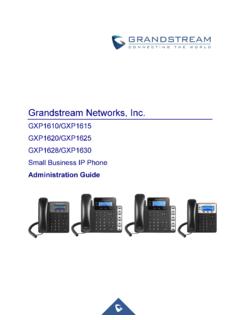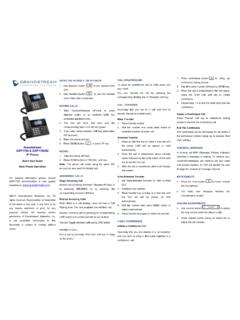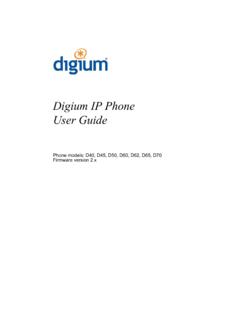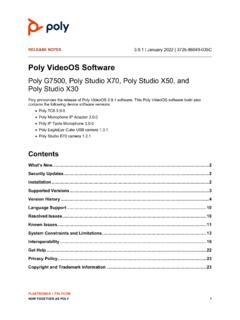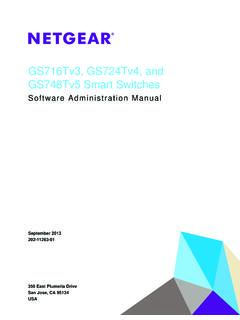Transcription of Grandstream Networks, Inc.
1 Grandstream Networks, Inc. VLAN (Virtual Local Area Network) Guide P a g e | 2 VLAN Guide Table of Contents SUPPORTED DEVICES .. 4 INTRODUCTION .. 5 ABOUT VLAN .. 6 6 Voice VLAN .. 7 VLAN 8 lldp ( link Layer discovery protocol ) .. 8 lldp -MED .. 9 configuring lldp via Configuration File .. 10 lldp Flow (Wireshark) .. 10 Manual Configuration .. 11 configuring VLAN Manually via Web GUI .. 11 configuring VLAN Manually via Configuration File .. 11 Screenshots Examples for lldp and Manual Configuration Settings .. 13 Automatic Configuration using DHCP VLAN option (GXV32xx only).
2 14 configuring DHCP VLAN option on GXV32xx via Web GUI .. 15 configuring the DHCP VLAN option on the GXV32xx via configuration file .. 16 DHCP VLAN Option Wireshark Flow .. 16 P a g e | 3 VLAN Guide Table of Figures Figure 1: Normal and VLAN-Tagged Ethernet 6 Figure 2: SIP clients VLAN architecture .. 7 Figure 3: lldp advertisement on GXP1625 .. 10 Figure 4: Screenshots for lldp and Manual Configuration Settings .. 13 Figure 5: Download and Install isc .. 14 Figure 6: Editing Configuration File .. 14 Figure 7: Listening 14 Figure 8: Editing .. 14 Figure 9: DHCP option 132 .. 15 Figure 10: Restart DHCP Service.
3 15 Figure 11: Enable DHCP VLAN .. 15 Figure 12: DHCP discovery on GXV3240 .. 16 Table of Tables Table 1: List of Supported 4 Table 2: Priority Level .. 6 Table 3: TLVs transported in LLDPDUs .. 8 Table 4: lldp -MED TLVs type .. 9 Table 5: lldp Option Location on The Web GUI .. 9 Table 6: Set VLAN Manually .. 11 Table 7: VLAN Manual Configuration .. 11 P a g e | 4 VLAN Guide SUPPORTED DEVICES Following table shows Grandstream products supporting VLAN protocol . Table 1: List of Supported Products Model VLAN Support lldp Support Firmware Enterprise IP Phones GXP21xx Yes Yes or higher Mid-Range IP Phones GXP17xx Yes Yes or higher Small Business IP Phones GXP16xx Yes Yes or higher IP Video Phones for Android GVC3380 Yes Yes or higher GXV3350 Yes Yes or higher GXV3370 Yes Yes or higher Full HD Conferencing System GVC3200/3202 Yes Yes or higher GVC3210 Yes Yes or higher GVC3220 Yes Yes or higher GVC3212 Yes Yes or higher Audio Conferencing System GAC2500 Yes Yes or higher Analog VoIP Gateways GXW42xx Yes Yes or higher Analog Telephone Adaptors HT8xx Yes
4 No or higher Cordless IP Phones DP750/752 Yes Yes or higher P a g e | 5 VLAN Guide INTRODUCTION VLAN (Virtual Local Area Network) allows to separate network devices in logical groups despite of their physical location. Only members in same VLAN can communicate with each other. It also confines the broadcast domain to its members. VLANs are implemented to achieve scalability, security and ease the network management and can quickly adapt to changes in network requirements and relocation of workstations and servers. is the standard that supports VLANs on an Ethernet network, its frames are distinguished from ordinary Ethernet frames by the insertion of a 4-byte VLAN tag (VLAN ID) into the Ethernet header.
5 VLANs are used to achieve the following: Increase performance: Grouping users into logical networks will increase performance by limiting broadcast traffic to users performing similar functions within workgroups. Additionally, less traffic will need to be routed, and the latency added to routers will be reduced. Improve manageability: VLANs make large networks more manageable by allowing centralized configuration of devices located in assorted locations. Increase security options: VLANs have the ability to provide additional security not available in a shared network environment. A switched network delivers packets only to the intended recipients and packets only to other members of the VLAN.
6 This allows the network administrator to segment users requiring access to sensitive information into separate VLANs from the rest of the general users regardless of physical location. P a g e | 6 VLAN Guide ABOUT VLAN General VLAN tag allows to distinguish between different VLAN broadcast domains on a group of LAN switches. The inserted field to the Ethernet frame is composed of four bytes (32 bits). The VLAN tag is a two-byte (16 bits) field inserted between the source MAC address and the Ethertype field in an Ethernet frame as shown on Figure 1. Another two-byte field, the Tag protocol Identifier (TPI or TPID), precedes the VLAN tag field.
7 Figure 1: Normal and VLAN-Tagged Ethernet Frames Two fields are necessary to hold one piece of information: TPID (Tag protocol Identifier): 2 Bytes after the source MAC address which will be set to a value of 0x8100 to denote that this frame carries or tag information. TCI (Tag Control Information): 2 Bytes which are made of the following: 3-bit user Priority Code Point (PCP) that sets a priority value between 0 and 7, which can be used for Quality of Service (QoS) priority traffic delivery, as shown on Table 1. 1-bit Canonical Format Indicator (CFI) that is a compatibility bit between Ethernet and other network structures, such as Token Ring.
8 For Ethernet networks, this value will also be set to zero. 12-bit VLAN Identifier (VID) identifies the VLAN that the frame belongs to. Table 2: Priority Level PCP Priority Acronym Traffic Types 1 0 (lowest) BK Background 0 1 BE Best Effort 2 2 EE Excellent Effort 3 3 CA Critical Applications 4 4 VI Video, < 100ms latency and jitter 5 5 VO Voice, < 10ms latency and jitter 6 6 IC Internetwork Control 7 7(highest) NC Network Control P a g e | 7 VLAN Guide Voice VLAN The Voice traffic is sensitive to delay and jitter, thus it requires a higher priority than data traffic to reduce the delay and packet loss during transmission, separating voice and data traffic using VLANs provides a solid security boundary, preventing data applications from reaching the voice traffic.
9 It also gives user a simpler method to deploy QoS, prioritizing the voice traffic over the data. This feature enables access port of the switch to affect the connected device to a separated logical group, once this feature is enabled the ports set on the voice VLAN will allow simultaneous access for the PC, therefore the device and PC can be connected to one switch port through the device, LAN port will be connected to the Switch and PC port to the PC, after configuring VLAN tags for PC and LAN port the device will tag all packets from those port with VLAN ID, the switch will then forward the received packets to the corresponding VLAN ID.
10 Figure 2: SIP clients VLAN architecture P a g e | 8 VLAN Guide VLAN CONFIGURATION There are 3 ways to get VLAN ID on Grandstream products for the LAN port: 1. discovery using lldp 2. DHCP VLAN Option 132, 133 3. Manual configuration Notes: - The Grandstream products only support manual method to get VLAN ID for the PC port. - DHCP VLAN options 132 and 133 are supported only on GXV32xx series. lldp ( link Layer discovery protocol ) The link Layer discovery protocol ( lldp ) is a Layer 2 discovery protocol defined in the IEEE Nodes transmit information about themselves and listen for information about the devices on each connection, lldp defines a standard SNMP MIB (Management Information Base) which can store information gathered locally and can be queried by SNMP to facilitate network management.



